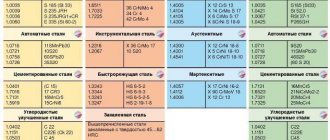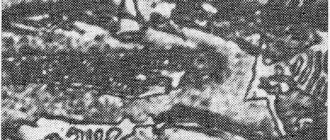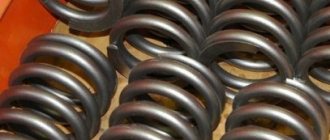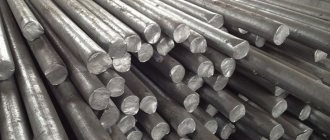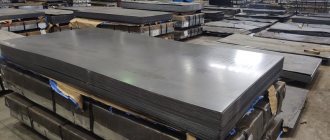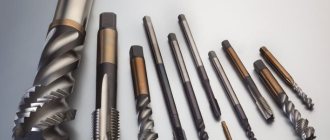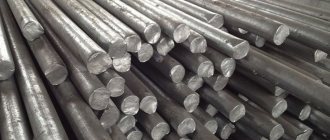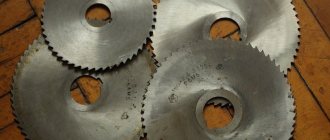General information
The quality of steel used in the manufacture of metal
structures is determined by its mechanical properties: resistance to static influences, dynamic influences and brittle fracture at various temperatures; plasticity indicators - relative elongation; resistance to delamination - bending in a cold state. The values of these indicators are established by GOST. In addition, the quality of steel is determined by its weldability, which is guaranteed by the appropriate chemical composition of the steel and its production technology.
Based on their strength, steel is divided into three groups:
- low carbon steels (ordinary quality)
- high strength steel
- high strength steel
The mechanical properties of steel and its weldability depend on the chemical composition, heat treatment and rolling technology.
The basis of steel is ferrite. Ferrite has low strength and is very plastic, therefore in its pure form it is not used in building structures. Its strength is increased by carbon additives - low-carbon steels of normal strength; alloying with manganese, silicon, vanadium, chromium and other elements - low-alloy steels of increased strength; alloying and thermal hardening of high strength steel.
Harmful impurities
These primarily include: phosphorus,
which, forming a solution with ferrite, increases the brittleness of steel, especially at low temperatures (cold brittleness) and reduces ductility at elevated temperatures;
sulfur,
which makes steel red-brittle (prone to cracking at temperatures of 800–1000 C) due to the formation of fusible iron sulfide. Therefore, the content of sulfur and phosphorus in steel is limited; So in carbon steel St 3, sulfur is up to 0.05% and phosphorus is up to 0.04%.
The mechanical properties of steel are adversely affected by saturation with gases that can enter the metal in a molten state from the atmosphere. Oxygen acts like sulfur, but to a greater extent and increases the brittleness of steel. Unfixed nitrogen also reduces the quality of steel. Hydrogen, although retained in an insignificant amount (0.0007%), but concentrating near inclusions in intercrystalline regions and located mainly along the boundaries of blocks, causes high stresses in microvolumes, which leads to a decrease in the resistance of steel, brittle fracture, a decrease in tensile strength and plastic properties become. Therefore, molten steel (for example during welding) must be protected from exposure to the atmosphere.
Heat treatment
In addition to alloying, a significant increase in the strength, deformation and other properties of steel is achieved by heat treatment due to the fact that under the influence of temperature, as well as heating and cooling modes, the structure, grain size and solubility of the alloying elements of steel change.
The simplest type of heat treatment is normalization. It consists of reheating the rolled product to the temperature of austenite formation and subsequent cooling in air. After normalization, the steel structure becomes more ordered, internal stresses are relieved, which leads to an improvement in the strength and plastic properties of rolled steel and its impact toughness. Therefore, normalization, being the simplest type of thermal improvement of steel, is used quite often.
With the rapid cooling of steel heated to a temperature exceeding the phase transformation temperature, hardening is obtained. For hardening, it is necessary that the cooling rate be higher than the phase transformation rate.
The structures formed after hardening give the steel high strength. However, its ductility decreases, and its tendency to brittle fracture increases. To regulate the mechanical properties of hardened steel and the formation of the desired structure, it is tempered, i.e., heated to a temperature at which the desired structural transformation occurs, held at this temperature for the required time and then slowly cooled.
Aging is promoted by:
- mechanical effects and especially the development of plastic deformations (mechanical aging);
- temperature fluctuations leading to changes in the solubility and rate of diffusion of components and therefore to their release (physico-chemical aging, dispersion hardening). Low heating (up to 150 – 200 C) can dramatically enhance the aging process.
With plastic deformation and subsequent slight heating, the intensity of aging increases sharply (artificial aging). Since aging reduces resistance to dynamic impacts and brittle fracture, it is considered a negative phenomenon. Steels that are contaminated and saturated with gases, such as boiling steel, are most susceptible to aging.
Undeoxidized steels boil when poured into molds due to the release of gases; such steel is called boiling steel
and turns out to be more clogged with gases and less homogeneous.
Boiling steels, having fairly good yield strength and tensile strength, have poor resistance to brittle fracture and aging.
To improve the quality of low-carbon steel, it is deoxidized by adding silicon from 0.12 to 0.3% or aluminum up to 0.1%; silicon (or aluminum), combining with dissolved oxygen, reduces its harmful effects. When combined with oxygen, deoxidizers form silicates and aluminates in a finely dispersed phase, which increase the number of crystallization sites and contribute to the formation of a fine-grained steel structure, which leads to an increase in its quality and mechanical properties. Deoxidized steels do not boil when poured into molds, which is why they are called calm steels.
Calm steel is more homogeneous, welds better, and better resists dynamic influences and brittle fracture. Mild steels are used in the manufacture of critical structures exposed to static and dynamic influences.
Semi-calm
The quality of steel is intermediate between boiling and calm. It is deoxidized by a smaller amount of silicon - in the amount of 0.05 - 0.15% (rarely by aluminum).
Low-carbon steels of ordinary quality
From the group of low-carbon steels of ordinary quality produced by the metallurgical industry in accordance with GOST 380 - 88, steel grade St3 is widely used in construction.
Steel grade St3 is produced boiling (ST3kp), semi-quiet (St3ps) and calm (St3sp).
Depending on the purpose, steel is supplied in the following three groups, which indicate the properties by which steel is standardized:
A - by mechanical properties;
B - by chemical composition;
B - according to mechanical properties and chemical composition
Since it is necessary to ensure strength and weldability for load-bearing building structures, as well as adequate resistance to brittle fracture and dynamic impacts, steel for these structures is ordered according to group B, i.e., with a guarantee of mechanical properties and chemical composition.
Steel grade St3 contains 0.14 – 0.22% carbon.
According to GOST 380 - 88, steel marking is done as follows: first put the corresponding letter designation of the steel group, then the grade, then the deoxidation method and finally the category; for example, steel of group B (supplied according to mechanical properties and chemical composition) grade St3 is semi-quiet, category 5 is designated VSt3ps5.
The category indicates which mechanical properties of steel are preserved at temperatures of -20 and +20 degrees Celsius. Ordinary quality steels are divided into 5 categories. The table of standardized indicators by category is given in GOST 535-88.
Production technology
The production of the alloy involves the processing of cast iron. In this case, unnecessary components are annealed, replacing them with ligature elements.
The process is carried out at the metallurgical plant using the following technologies:
- Open-hearth method. An open-hearth furnace is loaded with a mixture of cast iron and ore. To anneal excess carbon, melt at 2050°C and introduce alloys. The product (steel) is poured into containers and sent for rolling. The method is considered obsolete.
- Oxygen converter. A flow of air or an air-oxygen mixture is passed through the cast iron mass. The goal is to anneal the contents faster and more completely.
- Electric smelting. The raw material melts at 2210°C. The furnace is closed, so “contamination” of the alloy with gases is excluded. The method is expensive and is used to obtain an elite product.
- Straight. To blow through iron ore pellets, the furnace is heated to 1060°C. An ammonia-oxygen mixture plus carbon monoxide formed during the combustion of natural gas is used.
State diagram of iron-carbon alloys, steel region marked in blue
To obtain a material with improved characteristics, heat treatment is continued. The production method involves hardening, carburization, nitriding (accumulation of carbon or nitrogen on the surface to increase wear resistance), cyanidation (“pumping” the outer layer with nitrogen to speed up the process), and other operations.
Increased and high strength steels
For many types of structures, high-strength and high-strength steels are used.
Increased and high strength steels are supplied in accordance with GOST 19281 - 89 and GOST 19282 - 89. Depending on the standardized properties (chemical composition, tensile strength, yield strength, impact strength at different temperatures and after mechanical aging), according to GOST these steels are divided into 15 categories with a guarantee of mechanical properties at temperatures from -70 to +20 degrees Celsius.
The use of high-strength steel leads to metal savings of up to 20–25%, and high-strength steel – 25–50% compared to conventional carbon steel.
Varieties of some steels
| Steel grades | Heat treatment | Hardness (core-surface) |
| 35 | normalization | 163—192 HB |
| 40 | improvement | 192—228 HB |
| 45 | normalization | 179—207 HB |
| 45 | improvement | 235—262 HB |
| 55 | hardening and high tempering | 212—248 HB |
| 60 | hardening and high tempering | 217—255 HB |
| 70 | hardening and high tempering | 229—269 HB |
| 80 | hardening and high tempering | 269—302 HB |
| U9 | annealing | 192HB |
| U9 | hardening | 50—58 HRC |
| U10 | annealing | 197 HB |
| U10 | hardening | 62—63 HRC |
| 40X | improvement | 235—262 HB |
| 40X | improvement + hardening with high currents. frequencies | 45-50 HRC; 269—302 HB |
| 40ХН | improvement | 235—262 HB |
| 40ХН | improvement + hardening with high currents. frequencies | 48-53 HRC; 269—302 HB |
| 35ХМ | improvement | 235—262 HB |
| 35ХМ | improvement + hardening with high currents. frequencies | 48-53 HRC; 269—302 HB |
| 35L | normalization | 163—207 HB |
| 40L | normalization | 147HB |
| 40GL | improvement | 235—262 HB |
| 45L | improvement | 207—235 HB |
| 65G |
HB - Brinell hardness, HRC - Rockwell hardness.
GOST 27772-88
Since 1988, GOST for rolled steel for building steel structures was introduced. In this GOST, steel grades of ordinary quality, increased and high strength are given new names, for example S245, S390, S590K. The letter C means construction steel, the numbers conventionally indicate the yield strength of rolled products (the physical properties of steel), the letter K is a variant of the chemical composition. According to this GOST, steels are divided into 4 categories with a guarantee of mechanical properties at temperatures of -40, -70 degrees and after mechanical aging.
This GOST does not replace those mentioned above, but exists in parallel. So, according to different GOST standards, the same grade of steel can be designated by two names, for example, C235 and VSt3kp2 are the same steel. The conversion table for steel names is given in Appendix No. 1 to GOST 27772-88.
If you have any questions, call 281-57-57. Email
Physical properties of steel
The relationship between stress and strain in the elastic tensile region is a measure of the elasticity of a material. This ratio is called the modulus of elasticity or Young's modulus. A high Young's modulus is one of the most important properties of steels. Typically its value is 190-210 GPa or (19-21)×106 kg/cm2, which is about three times more than aluminum.
The main physical properties of steel include such material properties as density, thermal conductivity, elastic modulus, and Poisson's ratio.
Typical physical properties of steels are the following: - density: ρ = 7.7-8.1 kg/dm3; — elastic modulus: E = 190-210 GPa; — Poisson’s ratio: ν = 0.27-0.30; — thermal conductivity: k = 11.2-48.3 W/mK; — thermal expansion: α = 9-27×10-6 1/K.
